Brake drums are essential components of a drum brake system. Many vehicles rely on them for their rear wheels and emergency brakes.
As with any other brake component, your vehicle’s brake drums will wear out over time, resulting in decreased braking performance.
Thankfully, there are ways to find out if your brake drums are starting to fail.
Symptoms of a Bad Brake Drum
Here are some of the symptoms associated with a faulty brake drum:
Scraping or Grinding Noise
When the brake shoe friction material is worn to the point that the metal brake shoe backing contacts the drum, a scraping/grinding noise will be heard each time the brakes are applied. Sometimes, however, the brake hardware might be causing a scraping/grinding noise because of an out-of-place component and/or a broken brake shoe retaining spring. Dirt, rocks, and mud can also make their way into the brake drum on vehicles that are driven off-road and there may be strange drum brake noises for that reason.
Low Brake Pedal
A low brake pedal may be a sign that there is excessive clearance between the shoe and the drum. Since drum brakes are always self adjusting (except on old Volkswagens that require regular brake adjustments), the low pedal due to excessive shoe clearance needs to be investigated via a visual inspection rather than simply making adjustments. Of course, if somebody recently replaced the shoes (you or anybody else), and the shoes weren’t properly adjusted, a simple adjustment may be all that’s necessary.
In some cases, a low brake pedal may indicate a brake fluid leak or a faulty master cylinder. A fluid leak will usually be easy to spot. A bad master cylinder may or may not leak fluid into the booster.
The most common type of master cylinder failure will show up as a firm and high brake pedal that slowly falls away as you’re sitting at the drive-thru or at a traffic light. Releasing and re-applying the brake will generally return the brake pedal to the high and hard position, where it will slowly fall away under your foot again. In rare cases, there may be anti-lock brake components causing similar symptoms due to internal fluid leaks that aren’t visible.
If you’re new at doing wrench work or aren’t certain you can handle the repairs safely, always have your brakes checked by a professional mechanic.
Soft Brake Pedal
A worn or cracked brake drum may cause the brake pedal to feel spongy when pressed. Air in the brake lines due to unevenly distributed hydraulic air pressure may also be the reason behind this issue.
Note, however, that brake drums don’t usually crack and cause a soft pedal. This is very, very rare. More often, a soft brake pedal is due to air in the brake lines that needs to be bled out, and sometimes bleeding the brakes requires special procedures. Not all vehicle braking systems are piped the same way, so do some research before you bleed the brakes to make sure you’re doing it right, and whatever you do, don’t let the master cylinder run out of fluid while you’re bleeding the brakes or you’ll load the system with more air than you had to begin with.
Pulsation in the Brake Pedal
Brake drums that are no longer perfectly circular and/or balanced do not make constant contact with the brake shoes. Instead of squeezing the drum, the shoes would bounce up and down, resulting in a pulsation in the brake pedal.
Note that disc rotors are more commonly the cause of brake pedal pulsation, and they can be machined or replaced to take care of pulsation.
How Much Does a Brake Drum Replacement Cost?
An aftermarket brake drum replacement usually costs around $50 to $500, depending on the brand. Take note that this is only for the replacement brake drum and include other costs.

The average cost for a full drum brake replacement (including labor and installation) is around $500.
Brake drums are usually sold individually, in a 2-wheel set, or as part of a kit. When shopping for brake drums, make sure to check product specifications to ensure their compatibility with your vehicle.
What is Brake Fade?
Brake fade is the loss of stopping power due to reduced friction between the shoe linings and the brake drum. Most drum brakes are vulnerable to fade because they can’t dissipate heat efficiently. The heat produced during braking passes through the inside of the drum and out before it reaches the outside air.
Some drum brakes come with fins or ribs on their outer edge to disperse heat.
There are several types of brake fade that can affect brake drums. They include the following:
Mechanical Fade
This happens when the drum brake expands away from the brake lining due to intense heat. Once this happens, the brake shoes will move outward to stay in contact with the drum. The brake pedal may also drop closer to the floor because of the additional brake fluid directed into the hydraulic system.
Lining Fade
This happens when intense heat makes the friction coefficient of the brake lining become “slippery” enough to drop off. Lining fade also hardens the pedal and diminishes braking power.
Gas Fade
This happens due to extended hard braking when driving at high speeds, which produces dust particles and hot gases that can accumulate between the brake drum and brake shoe linings.
Gas fade also increases the force you’ll need to apply on the pedal to keep a constant level of stopping power.

Water Fade
This happens when there is excessive moisture between the shoes and the drum, causing decreased braking efficiency.
Although brake fade isn’t really caused by faulty drum brake components, its implications are the same. It will significantly diminish your vehicle’s braking performance, which may lead to major accidents on the road.
Importance of Regular Brake Maintenance
To prevent any dangerous situations that could come from reduced braking ability, it’s important to make sure that your braking system undergoes regular maintenance.
Here are some of the benefits of proper brake maintenance:
Improves Braking Performance
Proper maintenance will ensure that your brakes are in optimal condition, which also promotes better braking.
Enhances Safety
Brake issues contribute to thousands of road accidents every year. Conduct regular maintenance to ensure your brake system’s functionality and to guarantee your safety on the road.
Reduces Replacement Costs
Faulty brake drums usually cause metal grinding, which may cause premature wear or damage to other brake components. If the issue is not resolved right away, the affected components may also require replacement.
When you follow your vehicle’s regular brake maintenance schedule, you’ll be able to spot and replace faulty parts immediately. This will help you save a lot in the long run since it reduces the risk of damage in multiple brake components.
What are Drum Brakes and How Do They Work?
Brake drums are effectively part of the rotating assembly that includes the wheel hub, the wheel, and the tire. When the vehicle is moving, the brake drum is rotating as one with the wheel to which it’s connected.
The brake shoes, on the other hand, are secured to a stamped steel backing plate that is bolted to the axle or knuckle assembly. Brake shoes design can either be leading/trailing or duo-servo in design. Leading / Trailing brakes are shown on the left in the following illustration and the shoes are anchored both at the top and at the bottom. Notice that the adjuster is right under the wheel cylinder on the L/T design.
Duo Servo brake shoes (right on the following illustration) are anchored only at the top to a very steel pin powerfully connected to the backing plate above the wheel cylinder. While the shoes are the same size, the lining on the front Duo Servo shoe is shorter than the lining on the rear shoe. Thus, the front shoe is the primary shoe and the rear shoe is the secondary shoe.
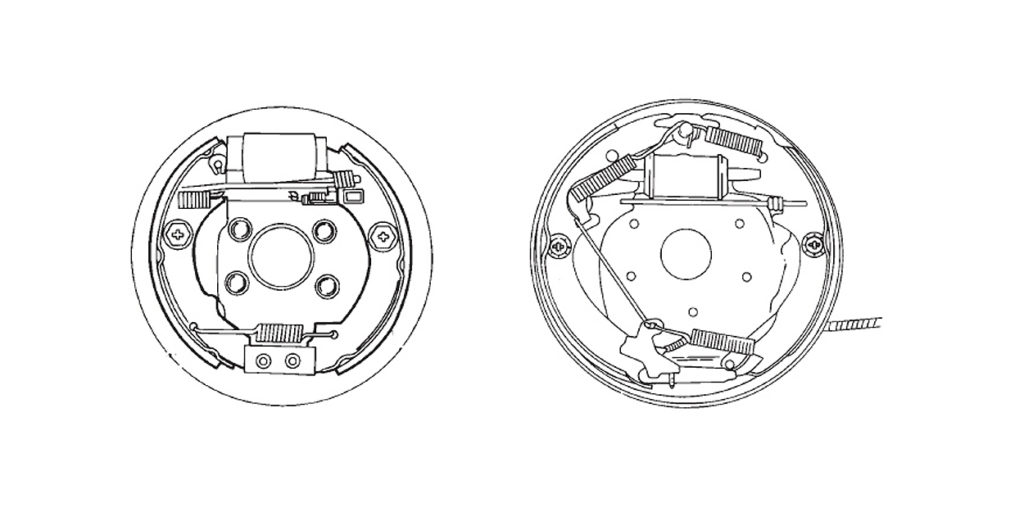
When fluid pressure is applied to the wheel cylinder, the brake shoes expand so their linings make contact with the brake drum, either slowing the drum, tire, and wheel in its rotation (forcefully) or bringing it to a complete stop. The duo-servo primary shoe tries to follow the rotation of the drum and through the adjuster at the bottom, forces the secondary shoe against the drum so that the top of the shoe is prevented by the steel pin from rotating with the drum. The drum’s movement is mitigated or completely stopped in its rotation.
The brake shoes’ friction material contacts the brake drum and it is the friction material that wears out in the process of converting kinetic energy to friction and heat energy as the brakes do their work. Of course, the tires must have good traction on the pavement in order for the vehicle to stop when the brakes are applied.
Products Mentioned in this Guide
Any information provided on this Website is for informational purposes only and is not intended to replace consultation with a professional mechanic. The accuracy and timeliness of the information may change from the time of publication.



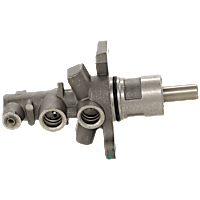 Brake Master Cylinder
Brake Master Cylinder
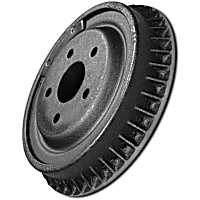 Brake Drum
Brake Drum
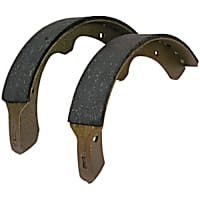 Brake Shoe Set
Brake Shoe Set
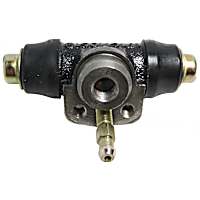 Wheel Cylinder
Wheel Cylinder
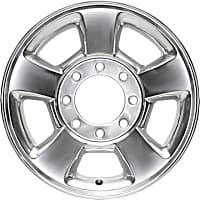 Wheel
Wheel



























